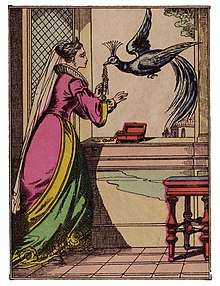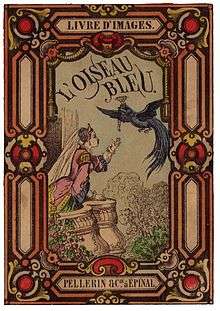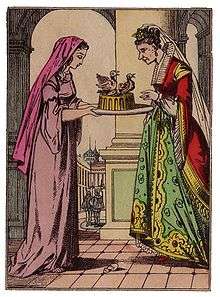The Blue Bird (fairy tale)
"The Blue Bird" is a French literary fairy tale by Madame d'Aulnoy, published in 1697.[1] An English translation was included in The Green Fairy Book, 1892, collected by Andrew Lang.[2][3][4]
| The Blue Bird | |
|---|---|
 The princess is given a necklace by the Prince, under the guise of a blue bird. | |
| Folk tale | |
| Name | The Blue Bird |
| Also known as | L'oiseau bleu |
| Data | |
| Aarne-Thompson grouping | ATU 432 (The Prince as Bird; The Bird Lover) |
| Region | France |
| Published in | Les Contes des Fées (1697), by Madame d'Aulnoy |
| Related | The Feather of Finist the Falcon; The Green Knight |
The tale is Aarne–Thompson type 432, The Prince as Bird. Others of this type include "The Feather of Finist the Falcon", "The Green Knight", and "The Greenish Bird".
Plot summary

After a wealthy king loses his dear wife, he meets and falls in love with a woman, who is also recently widowed and they marry. The king has a daughter named Florine and the queen also has a daughter named Truitonne. While Florine is beautiful and kind-hearted, Truitonne is spoiled, selfish and ugly and it is not too long before she and her mother become jealous of Florine's beauty.
One day, the king decides the time has come to arrange his daughters' marriages and soon, Prince Charming visits the kingdom. The queen is determined for him to marry Truitonne, so she dresses her daughter in all her finery for the reception and bribes Florine's ladies-in-waiting to steal all her dresses and jewels. But her plan backfires for when the Prince claps eyes on Florine, he falls in love with her at once and pays attention only to her. The queen and Truitonne are so furious that they badger the king until he agrees to lock Florine up for the length of the visit and they attempt to blacken her character to the Prince.
The queen sends Prince Charming many gifts, but when he hears they are from Truitonne, he rejects them. The queen angrily tells him that Florine will be locked in a tower until he leaves. Prince Charming is outraged and begs to speak with Florine for a moment. The devious queen agrees, meet the Prince instead. In the darkness of their meeting place, Prince Charming mistakes Truitonne for Florine and unwittingly asks for the princess's hand in marriage.
Truitonne conspires with her fairy godmother, Mazilla, but Mazilla tells her it will be difficult to deceive the Prince. At the wedding ceremony, Truitonne produces the Prince's ring and pleads her case. When Prince Charming realises he has been tricked, he refuses to marry her and nothing that Truitonne or Mazilla do can persuade him. At last, Mazilla threatens to curse him for breaking his promise and when Prince Charming will still not agree, Mazilla transforms him into a blue bird.
The queen, on hearing of the news, blames Florine; she dresses Truitonne as a bride and shows her to Florine, claiming that Prince Charming has agreed to marry her. She then persuades the King that Florine is so infatuated with Prince Charming that she had best remain in the tower until she comes to her senses. However, the bluebird flies to the tower one evening and tells Florine the truth. Over many years, the bluebird visits her often, bringing her rich gifts of jewels.
Over the years, the queen continues to look for a suitor for Truitonne. One day, exasperated by the many suitors that have rejected Truitonne, the Queen seeks Florine in her tower, only to find her singing with the bluebird. Florine opens the window to let the bird escape, but the Queen discovers her jewellery and realises that she has been receiving some kind of aid. She accuses Florine of treason, but the bluebird manages to foil the queen's plot.
For many days, Florine does not call the bluebird for fear of the queen's spy; but one night, as the spy sleeps soundly, she calls the bluebird. They continue to meet for some nights thereafter until the spy hears one of their meetings and tells the Queen. The Queen orders for the fir tree, where the bird perches, to be covered with sharp edges of glass and metal, so that he will be fatally wounded and unable to fly. When Florine calls for the bluebird and he perches on the tree, he cuts his wings and feet and cannot fly to Florine. When the bluebird does not answer Florine's call, she believes he has betrayed her. Luckily, an enchanter hears the Prince lamenting and rescues him from the tree.

The enchanter persuades Mazilla to change Prince Charming back into a man for a few months, after which if he still refuses Truitonne, he will be turned back into a bird.
One day, Florine's father dies and the people of the kingdom rise up and demand Florine's release. When the Queen resists, they kill her and Truitonne flees to Mazilla. Florine becomes queen and makes preparations to find King Charming.
Disguised as a peasant woman, Florine sets out on a journey to find the King and meets an old woman, who proves to be another fairy. The fairy tells her that King Charming has returned to his human form after agreeing to marry Truitonne and gives her four magical eggs. The first egg she uses to climb a great hill of ivory. The second contains a chariot pulled by doves that brings her to King Charming's castle, but she can not reach the king in her disguise. She offers to sell to Truitonne the finest jewellery that King Charming had given her, and Truitonne shows it to the King to find out the proper price. He recognizes it as the jewellery he gave to Florine and is saddened. Truitonne returns to Florine, who will sell them only for a night in the Chamber of Echoes, which King Charming had told her of one night: whatever she says in there will be heard in the king's room. She reproaches him for leaving her and laments all night long, but he has taken a sleeping potion, and does not hear her.
She breaks the third egg and finds a tiny coach drawn by mice. Again, she trades it for the Chamber of Echoes, and laments all the night long again, but only the pages hear her.
The next day, she opens the last egg and it holds a pie with six singing birds. She gives it to a page, who tells her that the King takes sleeping potions at night. She bribes the page with the singing birds and tells him not to give the King a sleeping potion that night. The King, being awake, hears Florine and runs to the Chamber of Echoes. Recognising his beloved, he throws himself at her feet and they are joyfully reunited.
The enchanter and the fairy assure them that they can prevent Mazilla from harming them, and when Truitonne attempts to interfere, they quickly turn her into a sow. King Charming and Queen Florine are married and live happily ever after.
Publication history
The tale of "The Blue Bird" (L'Oiseau Bleu) is one of Madame d'Aulnoy's most famous fairy tales,[5] with republications in several compilations.[6]
Legacy
The tale was one of many from d'Aulnoy's pen to be adapted to the stage by James Planché, as part of his Fairy Extravaganza.[7][8][9] The tale was retitled as King Charming, of the Blue Bird of Paradise when adapted to the stage.[10][11]
Mentions in other works
In the autobiography The Words from Jean-Paul Sartre, The Blue Bird was mentioned by the author as one of the first books he liked as a child.
In the ballet, The Sleeping Beauty, the Bluebird and Princess Florine make an appearance at Aurora's wedding celebration.
See also
| Wikisource has original text related to this article: |
References
- Miss Annie Macdonell and Miss Lee, translators. "The Blue Bird " The Fairy Tales of Madame D'Aulnoy. London: Lawrence and Bullen, 1892.
- Andrew Lang, The Green Fairy Book, "The Blue Bird"
- Buczkowski, Paul. "The First Precise English Translation of Madame D'Aulnoy's Fairy Tales." Marvels & Tales 23, no. 1 (2009): 59-78. www.jstor.org/stable/41388901.
- Palmer, Nancy, and Melvin Palmer. "English Editions of French "Contes De Fees" Attributed to Mme D'Aulnoy." Studies in Bibliography 27 (1974): 227-32. www.jstor.org/stable/40371596.
- Planché, James Robinson. Fairy Tales by The Countess d'Aulnoy, translated by J. R. Planché. London: G. Routledge & Co. 1856. p. 611.
- Thirard, Marie-Agnès. "Les contes de Madame d'Aulnoy: lectures d'aujourd'hui". In: Spirale. Revue de recherches en éducation, n°9, 1993. Littérature enfantine / de jeunesse, sous la direction de Francis Marcoin. pp. 87-100. [DOI: https://doi.org/10.3406/spira.1993.1768] www.persee.fr/doc/spira_0994-3722_1993_num_9_1_1768
- Feipel, Louis N. "Dramatizations of Popular Tales." The English Journal 7, no. 7 (1918): p. 444. Accessed June 25, 2020. doi:10.2307/801356.
- Buczkowski, Paul. "J. R. Planché, Frederick Robson, and the Fairy Extravaganza." Marvels & Tales 15, no. 1 (2001): 42-65. Accessed June 25, 2020. www.jstor.org/stable/41388579.
- MacMillan, Dougald. "Planché's Fairy Extravaganzas." Studies in Philology 28, no. 4 (1931): 790-98. Accessed June 25, 2020. www.jstor.org/stable/4172137.
- Adams, W. H. Davenport. The Book of Burlesque. Frankfurt am Main, Germany: Outlook Verlag GmbH. 2019. p. 74. ISBN 978-3-73408-011-1
- Planché, James (1879). Croker, Thomas F.D.; Tucker, Stephen I. (eds.). The extravaganzas of J. R. Planché, esq., (Somerset herald) 1825-1871. 4. London: S. French. pp. Vol 4, pp. 89-90.